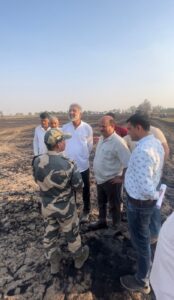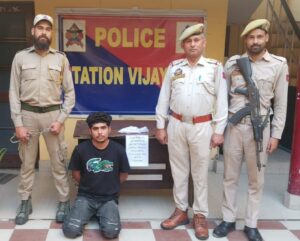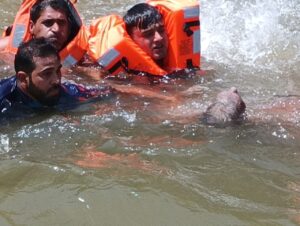Union Home Minister Amit Shah apprised with comprehensive update on the operational preparedness along the India-Pakistan border
Samba Times Special
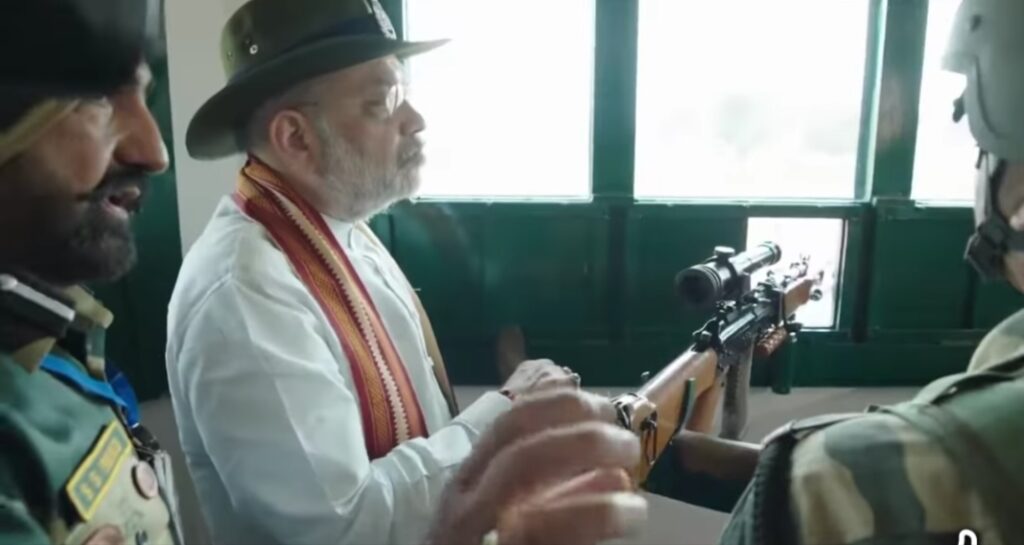
Kathua, April 07, 2025 – In a significant security briefing held at the Vinay Border Out Post in the Hiranagar sector of Kathua district, Deputy Inspector General (DIG) of the Border Security Force (BSF), SS Mand, provided Union Home Minister Amit Shah with a comprehensive update on the operational preparedness along the India-Pakistan border. This high-level interaction comes amid a series of recent encounters and heightened militant activities in the region emphasizing the government’s resolve to strengthen border security and counter cross-border threats.
During the briefing, DIG Mand outlined the BSF’s strategic measures, including troop deployment, advanced surveillance systems, and inter-agency coordination, to safeguard the volatile international boundary. The discussion highlighted the challenges posed by recent militant infiltrations and the BSF’s readiness to tackle such threats. Union Home Minister Amit Shah praised the BSF personnel for their relentless efforts in protecting the nation’s frontiers, particularly in light of the escalating security concerns in Kathua district.Recent Encounters and Militant Activities
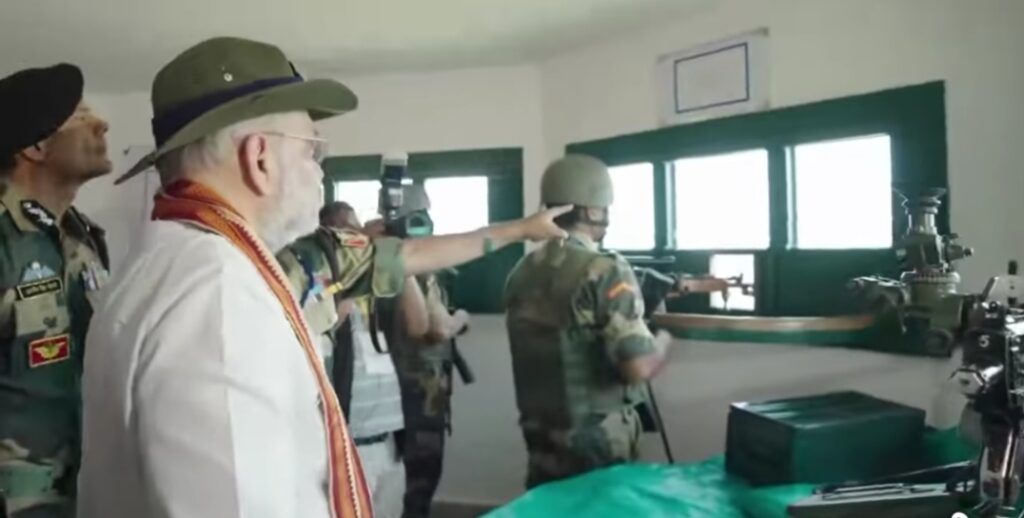
The Hiranagar sector and surrounding areas of Kathua have witnessed a surge in militant activities in recent weeks, with multiple encounters reported since late March 2025. These incidents have kept security forces on high alert, prompting intensified operations to neutralize infiltrating terrorists and dismantle their support networks.
Sanyal Village Infiltration and Encounter
The unrest began on March 23, 2025, when intelligence inputs indicated the presence of 4-5 newly infiltrated Pakistani terrorists in Sanyal village, located approximately five kilometers from the International Border in the Hiranagar sector. Security forces, including the Army, Special Operations Group (SOG) of Jammu and Kashmir Police, and the Central Reserve Police Force (CRPF), launched a cordon-and-search operation. The elite 1 Para Special Forces unit of the Indian Army also joined the effort, engaging suspected militants in the area. Unmanned Aerial Vehicles (UAVs) were deployed to track the terrorists, who managed to evade initial contact, slipping into nearby forests after a brief exchange of fire that injured a local girl. Four days later, on March 27, security forces re-established contact with the group in a forested area of the Safain forest belt. A fierce gunfight ensued, resulting in the elimination of two militants believed to be affiliated with the Pakistan-based Jaish-e-Mohammad (JeM) outfit. However, the encounter came at a heavy cost, with four policemen killed and three others injured. The remaining terrorists fled deeper into the jungle, triggering a multi-agency manhunt that continues to this day.
Juthana Encounter
The militants resurfaced on March 27 in the Juthana area, under Rajbagh Police Station, approximately 35 kilometers from Sanyal. Security forces engaged the group in the Ghati Juthana forest near Jakhole village, leading to another intense exchange of fire. The encounter resulted in injuries to several security personnel, including Special Police Officer Bharat Chalotra, who was later stabilized at Government Medical College Hospital in Jammu. The surviving terrorists escaped under the cover of darkness, further complicating efforts to neutralize them.
Rui Village Incident
On March 30, three suspected militants, dressed in black robes and carrying backpacks, entered a house in Rui village, Juthana area, around 7:45 PM. They demanded food and water from an elderly woman, who was alone at the time. After consuming the food, the terrorists forcibly took a 13-year-old child from the household, possibly as a guide or hostage. The child managed to escape by jumping from a hill, alerting authorities to the militants’ presence. This incident prompted an immediate cordon-and-search operation (CASO) in the area, with security forces intensifying their efforts to track the group.
Billawar-Panjtirthi Encounter
The latest confrontation unfolded on March 31 in the Panjtirthi area of Billawar, a mountainous region between Ghati and Billawar. A fierce gunfight erupted late Monday night when security forces, including the Army, J&K Police, and CRPF, detected suspicious movement based on intelligence inputs. The exchange of fire lasted approximately 40 minutes before ceasing, only to resume on Tuesday morning as the terrorists attempted to flee toward the Billawar mountains. Official sources reported that one militant was killed, with two others believed to be trapped in the dense forest. This marked the third major encounter in Kathua within nine days, reflecting the persistent threat posed by the infiltrating group.
Ongoing Operations and Security Response
The multi-agency operation to track down the remaining terrorists has now entered its 12th day as of April 3, with additional troops deployed across a 6-7 kilometer radius covering Billawar, Bhaddu, Ghatti, and Kog-Mandli. Security forces have employed drones, helicopters, sniffer dogs, and night cordons to prevent the militants from escaping the rugged terrain. Over 27 individuals, including six family members of a jailed overground worker (OGW), Mohammad Latief, have been detained for allegedly providing logistical support to the terrorists.
Impact of Amit Shah’s Visit to Kathua’s Hiranagar Sector
Union Home Minister Amit Shah’s visit to the Vinay Border Out Post in Kathua’s Hiranagar sector on April 07, 2025, amid a series of militant encounters and infiltration attempts, carries significant implications for security operations, troop morale, and the broader geopolitical narrative in Jammu and Kashmir. The visit, during which DIG BSF SS Mand briefed Shah on operational preparedness along the India-Pakistan border, is likely to influence multiple dimensions of the ongoing situation.
1. Boost to Security Forces’ Morale
Amit Shah’s presence at the border outpost, particularly in the wake of intense encounters in Sanyal, Juthana, Rui village, and Billawar-Panjtirthi, serves as a morale booster for the BSF, Army, J&K Police, and CRPF personnel engaged in high-risk operations. With four policemen killed and several others injured in recent clashes, the Home Minister’s visit demonstrates solidarity with the forces, reinforcing their resolve to combat militancy. His commendation of their efforts under challenging conditions could enhance operational motivation, signaling that their sacrifices are recognized at the highest levels of government.
2. Strengthened Operational Strategy
The briefing by DIG Mand likely included a review of the BSF’s response to the recent infiltration of 4-5 Pakistani terrorists, as well as the multi-agency operations that have resulted in the elimination of at least three militants since March 23. Shah’s visit could lead to immediate directives for enhanced coordination among security agencies, potentially accelerating the deployment of additional resources such as advanced surveillance drones, night-vision equipment, and specialized units like the Para Special Forces. The focus on plugging infiltration routes along the International Border may prompt a reassessment of vulnerable points, especially in the Hiranagar sector, which has emerged as a hotspot.
3. Policy and Infrastructure Upgrades
Given Shah’s emphasis on national security, the visit may catalyze long-term policy decisions to fortify the border. This could include increased funding for border fencing, smart surveillance systems, and infrastructure development in forward areas like Kathua. The discussions might also address the disruption of overground worker (OGW) networks, as evidenced by the detention of 27 individuals, including six linked to a jailed OGW. Such measures could weaken the logistical backbone supporting militant activities, reducing the frequency of incursions.
4. Political Messaging and Regional Stability
The visit sends a strong political message to both domestic and international audiences. Domestically, it reaffirms the central government’s commitment to maintaining peace and security in Jammu and Kashmir, a region that has seen a spike in militant activities since early 2025. By engaging directly with border security operations, Shah underscores the BJP-led government’s “zero tolerance” stance on terrorism, potentially bolstering public confidence in its handling of the situation.Internationally, the high-profile visit near the India-Pakistan border signals India’s vigilance and readiness to counter cross-border threats, particularly in light of the suspected involvement of Pakistan-based groups like Jaish-e-Mohammad. It may also serve as a diplomatic statement amid strained bilateral relations, emphasizing India’s proactive measures to secure its frontiers.
5. Local Community Impact
For the residents of Kathua, particularly in militancy-affected areas like Sanyal, Juthana, and Rui village, Shah’s visit could have a dual impact. On one hand, it may instill a sense of security, as the central government’s attention highlights efforts to curb the violence that has disrupted daily life—such as the abduction attempt in Rui or civilian injuries in Sanyal. On the other hand, intensified security operations following the visit might lead to temporary restrictions, cordons, and searches, potentially causing inconvenience to locals. The government may need to balance these measures with community engagement to maintain trust.
6. Acceleration of Ongoing Operations
With two militants still believed to be at large in the Billawar-Panjtirthi forests as of April 3, Shah’s visit could expedite the ongoing manhunt. His direct oversight might prompt the deployment of additional forces or technology to hasten the neutralization of the remaining threats. The visit could also lead to a review of operational lapses, such as the militants’ ability to evade capture across multiple encounters, ensuring a more decisive outcome in the coming days.
7. Broader Implications for Jammu and Kashmir
Kathua’s proximity to the Jammu region, traditionally less affected by militancy than the Kashmir Valley, highlights a potential shift in terrorist focus.
Shah’s visit could signal the beginning of a broader strategy to prevent the spread of militancy southward, protecting the relatively stable Jammu division. This might involve increased intelligence-sharing, preemptive strikes, and community-based vigilance programs to counter radicalization and infiltration.

